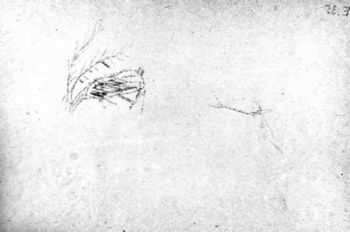IMAGE CITATION
Date: n.d.; after 1500
Subject:
Orignal Work:
Publish/Print:
Place: In situ: McGowan Lake, N.S., now underwater
Source: Nova Scotia Museum, Halifax
Reference Number: P179/ 10.23.120 (3612/E35)/ N-18,221
Image Use: Free for personal research and non-commercial educational use.
Request an application for commercial use.
The Nova Scotia Museum reserves the right to refuse requests.
IMAGE INFORMATION
The weapon the man is pointing at the caribou seems to be a musket, with lines to indicate the musket has been fired. George Creed, postmaster at Rawdon, N.S., traced many of the Mi'kmaq petroglyphs now located within the boundaries of Kejimkujik National Park, and at McGowan Lake, N. S. He examined the rock faces, went over those outlines he thought significant with a coloured pencil, then pressed dampened paper over the tracing; thus his images are reversed. The photos of his tracings are shown printed reversed here, to restore the original orientation of the carving. Creed's tracings are stored in mylar sheets at the Nova Scotia Museum and at the Public Archives of Nova Scotia. It must be kept in mind that Creed took images out of their contexts, in order to catalogue them by type. The McGowan Lake petroglyphs have been underwater since the building of a hydroelectric dam in the 1940s. In 1983 the dam was opened for repairs, the lake was drained, and the Nova Scotia Museum contracted archaeologist Brian Leigh Molyneaux to map and photograph the site, and to do mylar tracings of the carvings, which seem to have been preserved by the lake to a greater degree than those at Kejimkujik. Molyneaux's documentation (notes, photos, tracings) is on file at the Nova Scotia Museum (83.76).
KEYWORDS
men; petroglyphs; rock art; hunting; weapons; guns; animals; caribou; McGowan Lake; Nova Scotia


